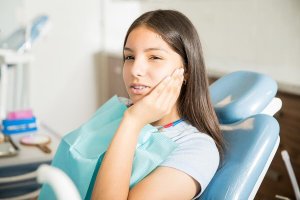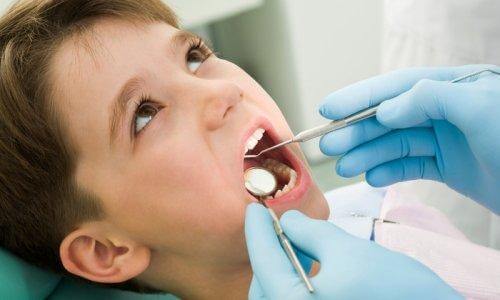Bruxism in Adolescence: Symptoms, Causes and Treatment

Bruxism in adolescence is one of the most common disorders. It affects approximately 20% to 30% of children and adolescents, but it can manifest at any age.
What causes bruxism? What can parents and specialists do to reduce the risk of this disorder developing in the long run?
Bruxism in adolescence
Bruxism is one of the most common dental health disorders. Although it may manifest at any age, it’s much more common in childhood and adolescence. The causes of this condition are unknown. However, there are treatments to eliminate or alleviate it.
Bruxism is a habit that develops unconsciously, usually during sleep, that consists of teeth grinding or jaw clenching. As a result, the person wakes up with severe facial muscle pain and even headaches.
One of the worst consequences of bruxism is teeth wear. In severe cases, they can even end up falling out. It can also trigger other health problems such as temporomandibular joint dysfunction.
Symptoms of Bruxism
Certain symptoms are key to determining whether a person suffers from bruxism or not. The most obvious sign is teeth grinding while the person is asleep, as well as waking up with a headache and face and neck pain.

A dentist can also detect bruxism in a routine appointment. In this case, the specialist will observe significant teeth wear or enamel fracture. This diagnosis is important to prescribe corrective measures as soon as possible.
Bruxism in adolescence: What to do?
Bruxism in adolescence should be carefully monitored. If appropriate measures aren’t taken, this condition can affect the sufferer in adulthood. Bruxism is quite common in adolescence and is related to stress in many cases.
The source of the problem must be determined so that the specialist can prescribe the most appropriate treatment. First of all, neurological diseases must be ruled out.
Then, the professional should study other triggers such as stress or habits associated with the development of this condition, such as nail biting, gum chewing, among others.
In addition to the treatment indicated by the specialist, the adolescent should eliminate or reduce the habits that lead to the development of bruxism.
“Bruxism is a habit that develops unconsciously, usually during sleep, that consists of teeth grinding or jaw clenching.”
Regarding treatment, the specialist may prescribe some muscle relaxants and painkillers for as long as they deem necessary. The teen should consume these drugs under strict surveillance.
On the other hand, the professional may also recommend other measures to help relieve the problem. For example, the sufferer can apply heat to relax their muscles or the professional may recommend a treatment to improve the teen’s bite or a dental mouthguard.
Bruxism and stress
As you’ve seen, the causes of bruxism aren’t well-known. However, it’s known that there’s a close relationship between this disorder and anxiety, stress, and sleeping problems.

The studies that have been carried out indicate that cases of bruxism are increasing rapidly, especially in big cities. This data can be associated with the high stress levels of modern life.
Regarding adolescents, there’s a relationship between young people who suffer from bruxism and bullying. Researchers discovered that children between the ages of 13 and 15 years old who are victims of verbal harassment are four times more likely to develop bruxism.
These reasons make it clear just how important it is to determine the real causes of this condition. In this regard, parents should pay attention to their children to see if they’re victims of verbal or physical harassment.
Since bruxism during adolescence is common, it’s important to determine its root cause and take steps to eliminate this habit as quickly as possible.
Bruxism in adolescence is one of the most common disorders. It affects approximately 20% to 30% of children and adolescents, but it can manifest at any age.
What causes bruxism? What can parents and specialists do to reduce the risk of this disorder developing in the long run?
Bruxism in adolescence
Bruxism is one of the most common dental health disorders. Although it may manifest at any age, it’s much more common in childhood and adolescence. The causes of this condition are unknown. However, there are treatments to eliminate or alleviate it.
Bruxism is a habit that develops unconsciously, usually during sleep, that consists of teeth grinding or jaw clenching. As a result, the person wakes up with severe facial muscle pain and even headaches.
One of the worst consequences of bruxism is teeth wear. In severe cases, they can even end up falling out. It can also trigger other health problems such as temporomandibular joint dysfunction.
Symptoms of Bruxism
Certain symptoms are key to determining whether a person suffers from bruxism or not. The most obvious sign is teeth grinding while the person is asleep, as well as waking up with a headache and face and neck pain.

A dentist can also detect bruxism in a routine appointment. In this case, the specialist will observe significant teeth wear or enamel fracture. This diagnosis is important to prescribe corrective measures as soon as possible.
Bruxism in adolescence: What to do?
Bruxism in adolescence should be carefully monitored. If appropriate measures aren’t taken, this condition can affect the sufferer in adulthood. Bruxism is quite common in adolescence and is related to stress in many cases.
The source of the problem must be determined so that the specialist can prescribe the most appropriate treatment. First of all, neurological diseases must be ruled out.
Then, the professional should study other triggers such as stress or habits associated with the development of this condition, such as nail biting, gum chewing, among others.
In addition to the treatment indicated by the specialist, the adolescent should eliminate or reduce the habits that lead to the development of bruxism.
“Bruxism is a habit that develops unconsciously, usually during sleep, that consists of teeth grinding or jaw clenching.”
Regarding treatment, the specialist may prescribe some muscle relaxants and painkillers for as long as they deem necessary. The teen should consume these drugs under strict surveillance.
On the other hand, the professional may also recommend other measures to help relieve the problem. For example, the sufferer can apply heat to relax their muscles or the professional may recommend a treatment to improve the teen’s bite or a dental mouthguard.
Bruxism and stress
As you’ve seen, the causes of bruxism aren’t well-known. However, it’s known that there’s a close relationship between this disorder and anxiety, stress, and sleeping problems.

The studies that have been carried out indicate that cases of bruxism are increasing rapidly, especially in big cities. This data can be associated with the high stress levels of modern life.
Regarding adolescents, there’s a relationship between young people who suffer from bruxism and bullying. Researchers discovered that children between the ages of 13 and 15 years old who are victims of verbal harassment are four times more likely to develop bruxism.
These reasons make it clear just how important it is to determine the real causes of this condition. In this regard, parents should pay attention to their children to see if they’re victims of verbal or physical harassment.
Since bruxism during adolescence is common, it’s important to determine its root cause and take steps to eliminate this habit as quickly as possible.
All cited sources were thoroughly reviewed by our team to ensure their quality, reliability, currency, and validity. The bibliography of this article was considered reliable and of academic or scientific accuracy.
- Firmani, M., Reyes, M., Becerra, N., Flores, G., Weitzman, M., & Espinosa, P. (2015). Bruxismo de sueño en niños y adolescentes. Revista chilena de pediatría, 86(5), 373-379. https://scielo.conicyt.cl/scielo.php?pid=S0370-41062015000500012&script=sci_arttext&tlng=en
- Vicuña, D., Id, M. E., & Oyonarte, R. (2010). Asociaciones entre signos clínicos de bruxismo, ansiedad y actividad electromiográfica maseterina utilizando el aparato Bite Strip® en adolescentes de último año de Enseñanza Media (Secundaria). International journal of odontostomatology, 4(3), 245-253. https://scielo.conicyt.cl/scielo.php?pid=S0718-381X2010000300007&script=sci_arttext&tlng=e
- Frugone Zambra, R. E., & Rodríguez, C. (2003). Bruxismo. Avances en odontoestomatología, 19(3), 123-130. http://scielo.isciii.es/pdf/odonto/v19n3/original2.pdf
- Firmani, M., Reyes, M., Becerra, N., Flores, G., Weitzman, M., & Espinosa, P. (2015). Sleep bruxism in children and adolescents Bruxismo de sueño en niños y adolescentes. http://repositorio.uchile.cl/handle/2250/158962
This text is provided for informational purposes only and does not replace consultation with a professional. If in doubt, consult your specialist.








